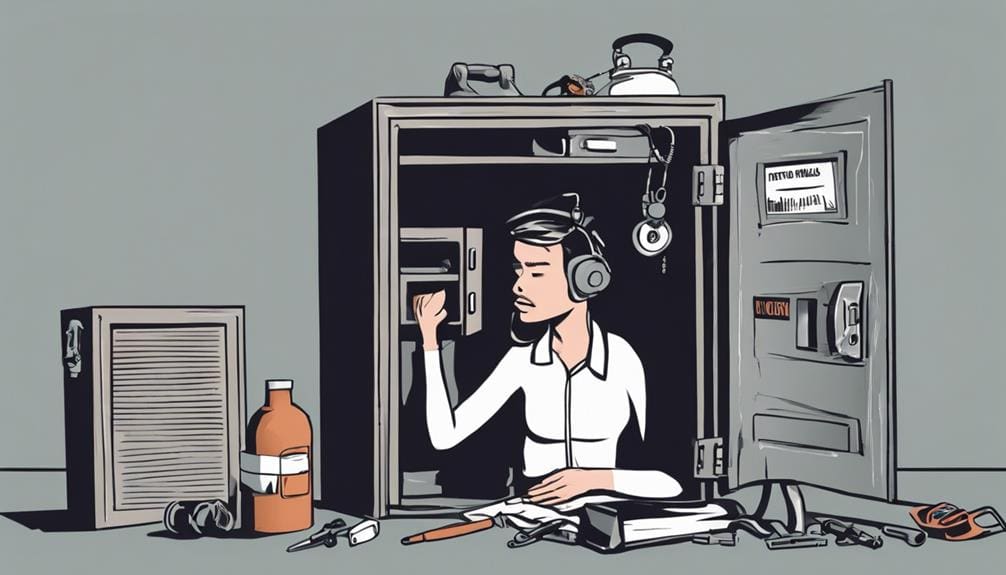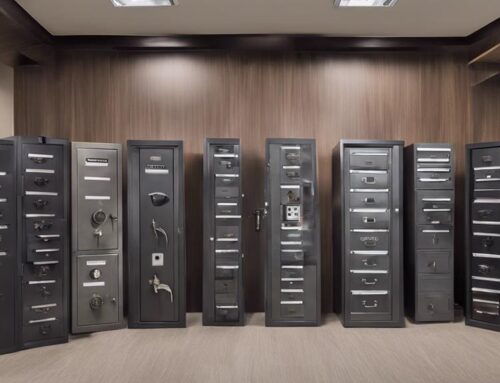If you’ve forgotten your safe combination, stay calm. First, identify your safe type—key-operated, combination, electronic, or biometric. Gather proof of ownership like receipts or manuals. For electronic safes, look for a reset button or use an override key. Combination safes may need a locksmith or precise dialing techniques. Biometric safes often allow backup entry methods. Always wear protective gear and follow safety guidelines. Avoid rushing and forceful handling. If necessary, consult a professional locksmith with ownership proof. For detailed steps and tips on safe maintenance, keep going.
Key Takeaways
- Refer to the user manual for reset instructions or default combination.
- Contact the safe manufacturer with proof of ownership for combination retrieval assistance.
- Consider professional locksmith services to open the safe without damage.
- Test common combinations slowly and listen for clicking sounds.
- Use the backup override key if available and stored separately.
Identify Your Safe Type
To regain entry to your safe, the first step is to identify its type by examining the locking mechanism. Begin by closely inspecting your safe’s front panel. If you notice a keyhole, you have a key-operated safe. These safes require a physical key to open.
Next, look for a rotary dial with numbers. This indicates a combination safe, which opens when a specific sequence of numbers is dialed. If instead you find a digital keypad, you’re dealing with an electronic safe. These safes require entering a numerical code to access.
Lastly, check for a fingerprint scanner. If present, you have a biometric safe, which uses fingerprint recognition for entry.
Understanding the safe type is essential because each requires a specific approach to regain entry. Key-operated safes might need a locksmith if the key is lost. Combination safes could require the original combination or professional help to reset. Electronic safes often have a backup key or reset option, while biometric safes may have alternative entry methods or reset procedures.
Verify Legal Ownership
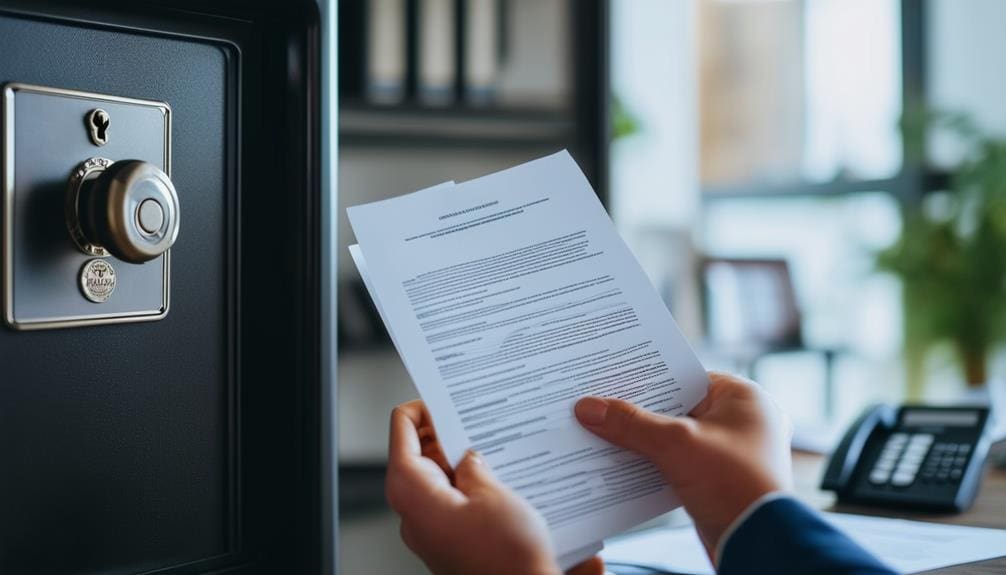
To verify legal ownership, gather proof of purchase or any documentation that shows you own the safe. Contacting the safe’s manufacturer can also help confirm your ownership status. Make sure you have all necessary documents ready to comply with legal requirements and to facilitate assistance from locksmiths or technicians.
Proof of Ownership Documents
When verifying legal ownership of your safe, you’ll need documents like purchase receipts, user manuals, or warranty information to prove your claim. Proof of ownership documents are essential when you’ve forgotten your safe’s combination. These documents can include purchase receipts that show where and when you bought the safe, user manuals that came with the initial purchase, and warranty information that often contains critical details about your ownership.
Additionally, notarized statements can serve as strong proof of ownership, especially if the safe was a gift or inherited. If you have the original keys, these can also act as evidence. Safe serial numbers are particularly important; they uniquely identify your safe and are often required for legal ownership verification.
Manufacturers might have specific documentation requirements for providing assistance with forgotten combinations. Making sure you have all necessary proof can expedite the process and prevent unauthorized access. Always keep these proof of ownership documents in a secure location separate from the safe itself to avoid a scenario where you can’t access them when needed. This meticulous approach guarantees you can verify your legal ownership promptly and regain access to your safe.
Contacting Safe Manufacturer
After gathering all your proof of ownership documents, contact the safe manufacturer to confirm your legal ownership and request assistance with retrieving your combination. Start by reaching out to the manufacturer through their customer service channels, such as phone or email. Inform them that you’ve forgotten your combination and need help regaining access to your safe.
You’ll need to provide proof of ownership, which may include a receipt, warranty card, or any other purchase documentation. This step is essential for ownership verification and guaranteeing compliance with legal requirements. Manufacturers have specific guidelines for combination retrieval, so make sure you follow their instructions precisely.
Be prepared to answer questions and submit necessary paperwork as part of the process. The manufacturer will verify your ownership and may provide a new combination or instructions to reset your existing one. Following manufacturer guidelines will help expedite the process and make sure you regain access to your safe in a timely manner.
Safety Precautions
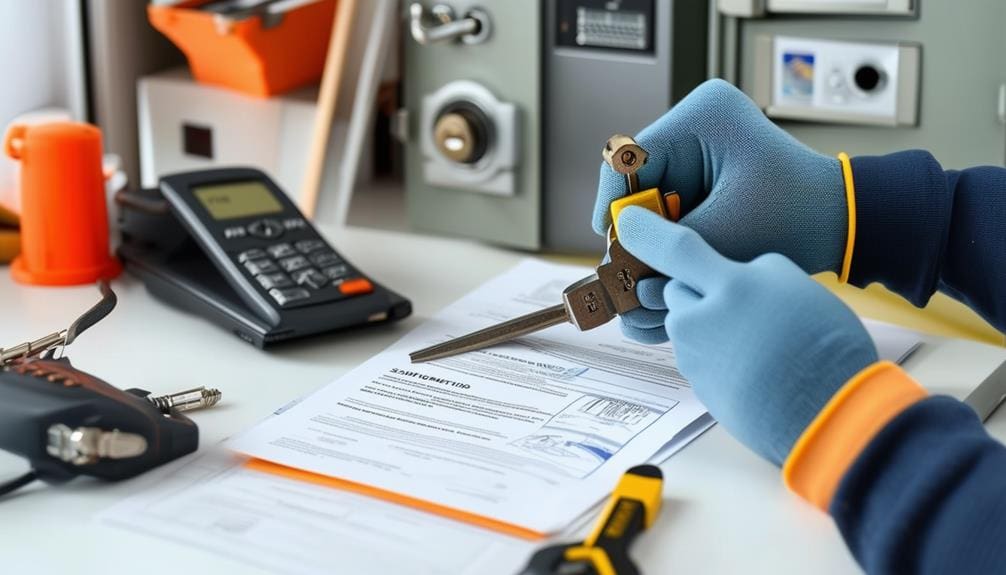
Prioritizing your safety is pivotal, so always wear protective gear like gloves and safety glasses when attempting to regain access to your safe. Taking these precautions helps prevent injuries and protects you from any unexpected hazards. It’s vital to avoid damaging the safe by using appropriate tools and techniques recommended for safe manipulation.
Here are key precautions to follow:
- Wear protective gear: Gloves and safety glasses are a necessity.
- Use proper tools: Avoid makeshift tools that could harm the safe.
- Understand legal implications: Ensure you’re compliant with local regulations when accessing your safe without the combination.
- Seek professional assistance: A reputable locksmith can safely and efficiently help you regain access.
Understanding the legal implications of accessing a safe without the combination is crucial. Make sure you’re compliant with all regulations to avoid any legal issues. If at any point you feel uncertain or uncomfortable, consider seeking professional assistance. A reputable locksmith can provide the expertise needed to regain access to your safe safely and efficiently, minimizing the risk of damage or injury. By taking these meticulous precautions, you’ll secure a safer and more effective process, ultimately helping you regain access to your valuable belongings.
Using an Override Key
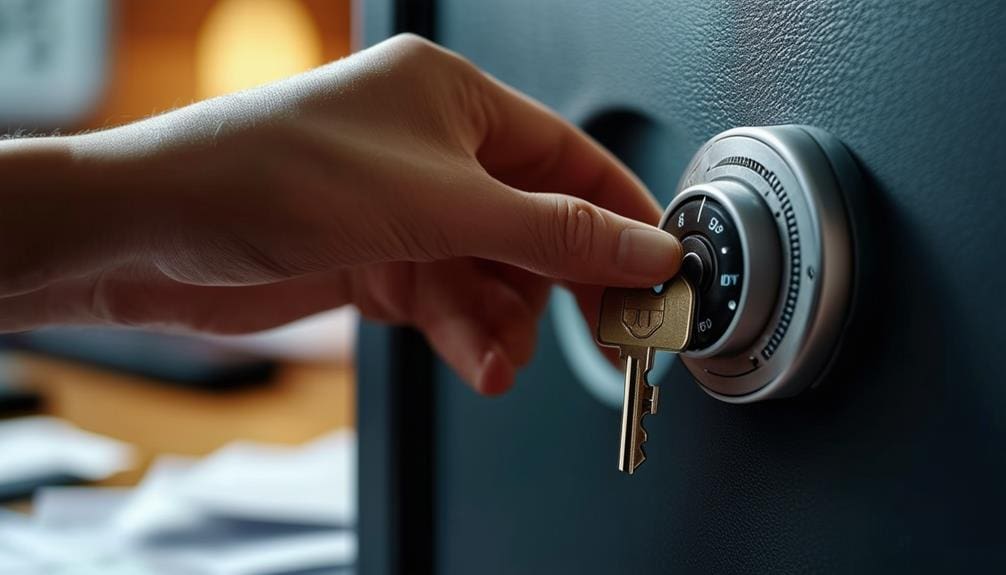
In the event that you forget the combination to your safe, using an override key offers a straightforward and efficient solution to regain access. Many safes come equipped with override keys, which allow you to bypass the combination lock entirely. This physical key can open the safe when the combination is either forgotten or malfunctioning.
First, check your safe’s user manual or contact the manufacturer to confirm if your model includes an override key option. Once you’ve verified this, locate your override key. It’s vital to keep this key in a secure location separate from the safe for emergency situations. Using the override key is simple: insert it into the designated keyhole, typically located on the front of the safe. Turn the key, and you should hear the lock mechanism disengage, granting you immediate access to the safe.
Manipulating Combination Locks
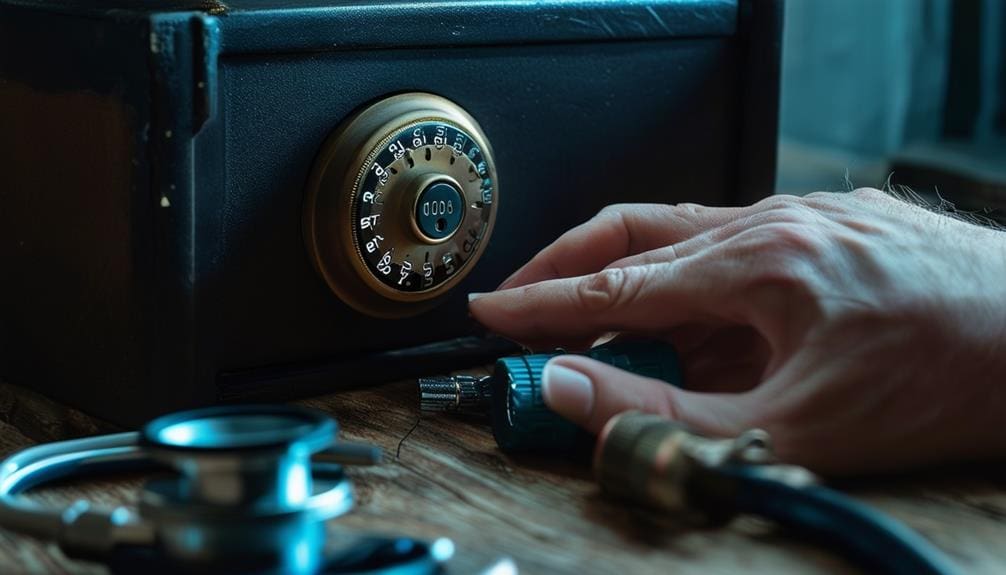
To manipulate combination locks successfully, you’ll need to master dial rotation techniques, listen for subtle clicks indicating the alignment of internal components, and test common combinations. Each method requires patience, precision, and a keen ear to detect the mechanical feedback. These skills, honed through practice, will greatly improve your chances of accessing the safe without causing any harm.
Dial Rotation Techniques
When manipulating combination locks, start by turning the dial left several times to clear any previous settings before stopping on the first number. This initial step guarantees the combination lock is reset and ready for precise alignment.
Next, rotate the dial to the right past the second number, then stop on it. After this, turn the dial left to the final number of the combination. Always use a light touch and be accurate when manipulating the dial to avoid overshooting or undershooting the numbers, which can prevent you from opening the safe.
Patience and attentiveness are key to successfully accessing the safe without the combination. Here are some tips to help with precise alignment:
- Rotate the dial smoothly and consistently: Avoid sudden movements to maintain control.
- Turn left and right as needed: Follow the specified directions to avoid mistakes.
- Verify each number is accurately aligned: Double-check alignment before proceeding.
- Practice the sequence several times: Familiarity with the process can enhance accuracy.
Listening for Clicks
Listening for clicks while turning the dial can provide critical clues to opening the safe, adding another layer of technique to the dial rotation methods you’ve already practiced. Each click corresponds to a specific number in the combination, aiding you in decoding the sequence required to open the safe.
Begin by turning the dial slowly and methodically. Place your ear close to the lock to better hear the subtle clicks. You’ll need patience and a keen ear to distinguish these faint sounds. As you rotate the dial, pay attention to the points where you feel and hear distinct clicks; these often indicate the correct numbers in the combination.
It’s essential to document each click’s position meticulously. Note down any number that produces a noticeable click. These clicks are your primary indicators and will help you decode the combination step by step. Continue this method of listening and documenting until you’ve identified all the numbers in the sequence.
This approach requires precision. Rushing or missing a click can lead to incorrect conclusions, so take your time. With focus and careful listening, this method can effectively help you open your safe without the original combination.
Testing Common Combinations
Starting with testing common combinations like 0-0-0 or 1-2-3 can save time and help quickly determine if the safe uses a pre-set code. By beginning with these common combinations, you can swiftly eliminate the simplest possibilities.
In manipulating combination safes, follow these steps meticulously:
- Turn the dial left and right following standard combination lock procedures.
- Pay attention to any resistance or clicking sounds, indicating potential correct numbers in the combination.
- Test different sequences based on the safe’s design, such as left-right-left or right-left-right patterns.
- Keep track of each attempted combination to avoid repeating unsuccessful ones.
When you manipulate the dial, make sure you’re turning it smoothly and carefully. Listen closely for any subtle clicks or resistance, which might hint at correct numbers. Keeping meticulous notes on each combination you try will prevent you from wasting time on repeats.
Resetting Electronic Safes
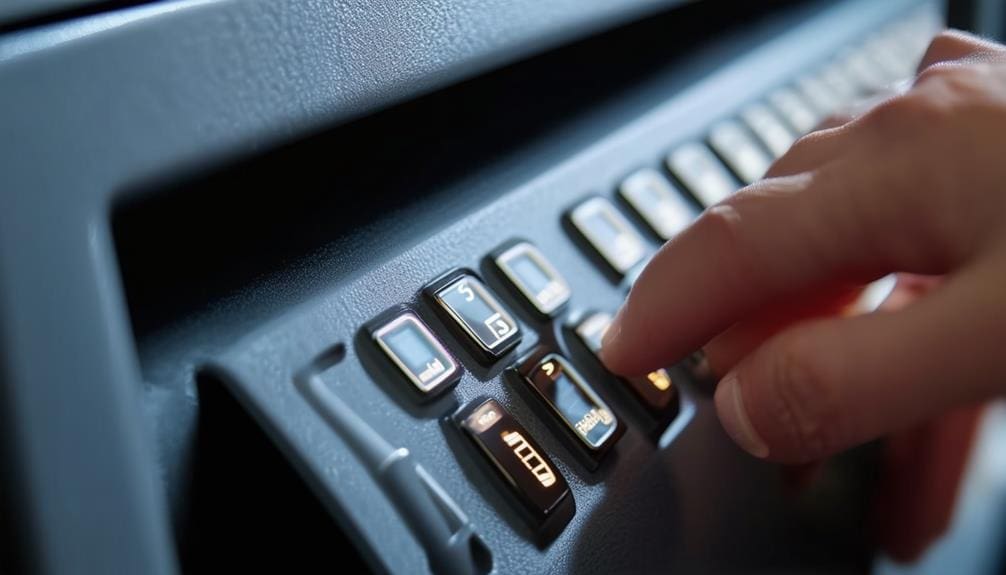
First, accurately identify your safe’s model to guarantee you follow the correct reset procedures. Each model of modern safes might have different steps for resetting the electronic combination. Start by consulting your safe’s manual or searching online with your model number.
Once you’ve identified the model, locate the reset button. Typically, this button is inside the safe, near the battery compartment. You’ll need to open the safe using an override key if it’s locked. If the safe opens, press and hold the reset button for a few seconds until a confirmation light or signal appears. This usually indicates that the factory default code is reactivated.
Next, use the factory default code provided by the manufacturer to initiate the reset process. Enter this code to access the reset mode of your safe. Follow the instructions to set up a new access code, making sure it’s something memorable yet secure.
Regular maintenance of your safe’s battery and electronics is essential to avoid future lockouts. If you encounter difficulties or the reset procedure fails, it might be time to consult a professional locksmith for assistance. A locksmith can help open a safe without damage and guarantee the system is properly reset.
Professional Locksmith Help
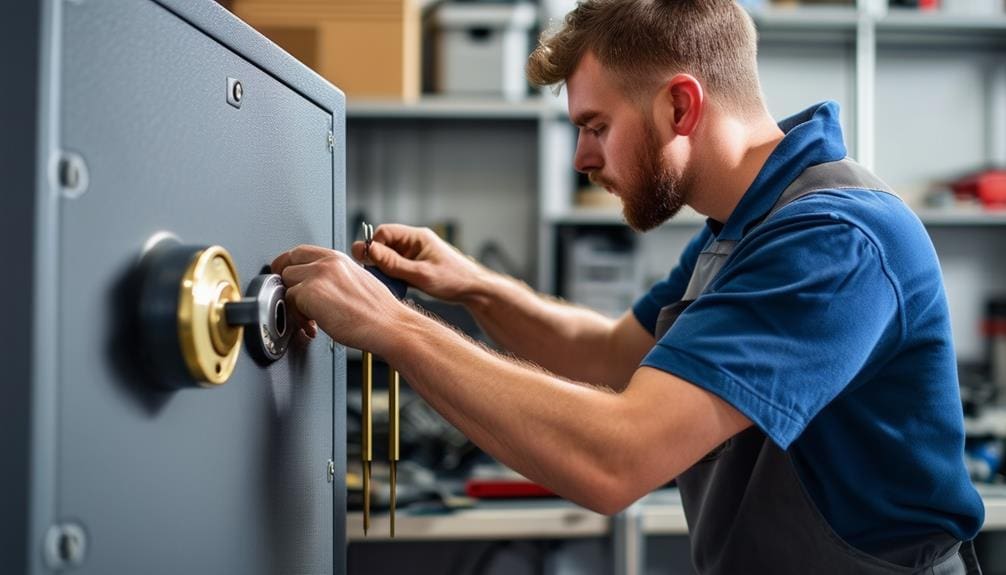
When you’re locked out of your safe and can’t resolve it yourself, professional locksmiths can provide the specialized assistance you need. Locksmiths use advanced tools and techniques to address various safe lockouts, whether it’s forgotten combinations or jammed locks.
First, you’ll need to present evidence of ownership before they help you. This step is pivotal to ensure that the service is provided to the rightful owner.
Choosing a reputable and experienced locksmith is fundamental. This guarantees that your safe is handled with the utmost care and professionalism. Not all locksmiths specialize in safe opening, so seek out those with specific expertise in this area.
Take into account the cost of locksmith services. These can vary widely, so it’s wise to get an estimate upfront. Be aware that urgent services, especially those requiring 24-hour assistance, might come with additional fees.
Here are key points to keep in mind:
- Verification: Always provide proof of ownership.
- Reputation: Choose a reputable and experienced locksmith.
- Cost: Understand the cost of locksmith services beforehand.
- Availability: Look for locksmiths offering 24-hour services for emergencies.
Preventive Measures
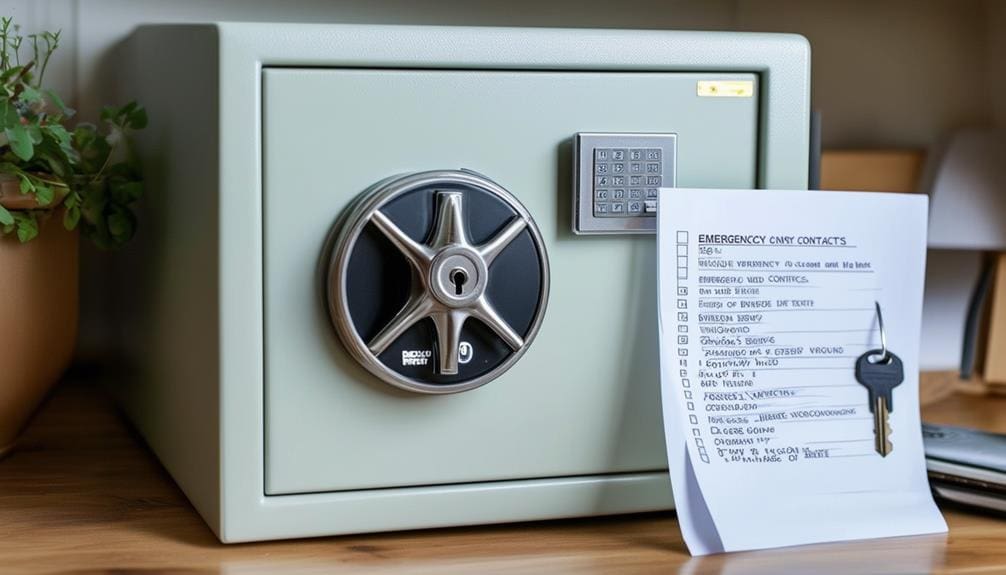
Implementing preventive measures is vital to make certain you don’t face future lockout situations with your safe. Start by creating duplicate keys and storing them in a secure location. This way, if you misplace the original, you can quickly regain access. Additionally, using key tracker devices can help you keep tabs on your keys, minimizing the risk of losing the key altogether.
For those seeking added convenience and security, consider investing in keyless safes. These eliminate the need for physical keys, reducing the chances of lockout due to losing the key. Instead, you can rely on codes or biometric access, which are often more convenient and secure.
It’s also important to implement proactive measures to avoid forgetting or misplacing your safe combination. Write the combination down and store it in a secure location, separate from the safe. This guarantees you have a backup without compromising security. Periodically test the combination to keep it fresh in your memory.
Common Mistakes

Many individuals rush through various combinations, which can result in frustration and even lock the safe permanently. To avoid this, understanding the common mistakes and how to prevent them is crucial.
Firstly, applying too much force to the safe’s dial or handle can cause irreversible damage to the internal locking mechanism. Always handle the safe delicately and use the necessary tools properly. Neglecting the safe’s user manual or manufacturer’s instructions is another frequent error. These guides often contain important information about different types of safes and specific steps for accessing them without causing damage.
Furthermore, not keeping a record of your attempts can lead to repeated unsuccessful efforts, adding to your frustration. It is vital to document each combination you’ve tried. Lastly, many people overlook the significance of consulting professional locksmiths and safe experts. Their expertise can save you time and prevent damage that DIY methods might cause.
Here’s a brief summary of common mistakes:
- Rushing through combinations
- Using excessive force
- Ignoring the user manual
- Failing to seek professional help
Tips for Safe Maintenance
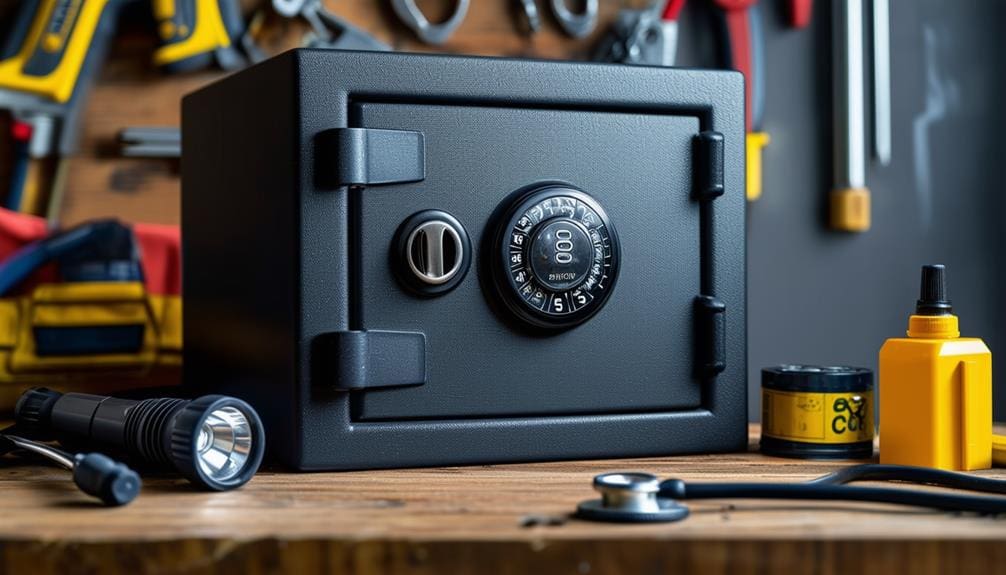
Regularly check the locking mechanisms of your safe to guarantee they operate smoothly and last longer. Always store your access methods, like keys or combinations, in a secure location to prevent unauthorized access. Consider consulting a professional locksmith for expert advice on maintenance and repairs.
Regular Lock Mechanism Checks
To ensure your safe functions at its peak, it’s crucial to examine and test the lock mechanism regularly for smooth operation and signs of wear. Conducting routine lock mechanism checks guarantees that your safe remains secure and operational.
Commence by examining and testing the lock mechanism. Search for any indications of wear or malfunction. This step aids in detecting potential issues early on.
Subsequently, cleanse the lock components periodically. Dust, debris, or other blockages can hinder the lock’s operation. Regular cleaning prevents these elements from causing disruptions.
Remember to apply lubricant to the moving parts of the lock. Adhere to the manufacturer’s suggestions to prevent rust and maintain optimal efficiency.
Lastly, verify the door alignment. Confirm that the lock engages correctly and securely when you secure and open the safe. Misalignment can lead to lock failure.
Here’s a brief checklist to maintain your safe in excellent condition:
- Examine and test the lock mechanism for smooth operation.
- Cleanse the lock components to eliminate dust and debris.
- Apply lubricant to moving parts to prevent rust.
- Verify door alignment for proper lock engagement.
For the finest outcomes, arrange professional maintenance by a locksmith. They can evaluate the lock mechanism, make adjustments, and address any potential issues proactively.
Secure Storage of Keys
While guaranteeing the lock mechanism is in prime condition, it’s equally crucial to securely store your spare keys to maintain the overall security of your safe. First, always keep spare keys in a secure location away from the safe itself to prevent unauthorized access. Utilize a key tracker device or a key safe box for added security and ease of retrieval.
Regularly check the condition of your spare keys to make sure they remain functional in emergencies. Implementing a key management system is crucial for tracking keys associated with safes and other secure storage units. This system will help you monitor the whereabouts of your keys, ensuring they are always accounted for.
Additionally, rotate spare keys periodically. This practice not only confirms the functionality of all spare keys but also strengthens your access protocols by preventing wear and tear on any single key. By updating access protocols and rotating keys, you enhance the overall security of your stored keys.
These steps—secure location storage, using a key tracker device, regular checks, a key management system, and key rotation—are essential for maintaining the security and functionality of your safe’s access methods.
Frequently Asked Questions
How to Unlock a Safe if You Forgot the Code?
To open a safe if you forgot the code, explore safe cracking techniques, locksmith assistance, resetting options, and brute force methods. Online resources can help, but avoid common mistakes. Opt for professional help if necessary.
What if I Forgot the Combination on My American Security Safe?
Did you know 35% of safe owners forget their combinations? If you forgot your American Security safe combination, consider safe locksmith services for safe combination recovery or safe emergency access. Avoid safe security vulnerabilities by not attempting unsafe DIY safe cracking techniques.
What Do You Do if You Forgot Your Sentry Safe Combination?
If you forgot your Sentry Safe combination, you can use safe combination recovery on their website, try safe manual overrides, or contact a locksmith for safe cracking techniques. You might need to request a safe combination replacement.
How Do I Find the Combination to My Old Safe?
Dust off that old safe! Start with safe cracking techniques or use a safe key. If that fails, try resetting the safe combination or replacing safe locks. Hiring locksmith help and following safe maintenance tips guarantee security upgrades.
Conclusion
If you forget your safe combination, don’t panic. Identify your safe type, verify ownership, and take safety precautions. Use an override key, try manipulating the lock, or consult a professional locksmith. Prevent future issues by keeping records, practicing maintenance, and avoiding common mistakes. By staying proactive, staying prepared, and staying informed, you’ll guarantee your valuables remain secure and accessible. Follow these steps meticulously, and you’ll regain access to your safe efficiently and effectively.

